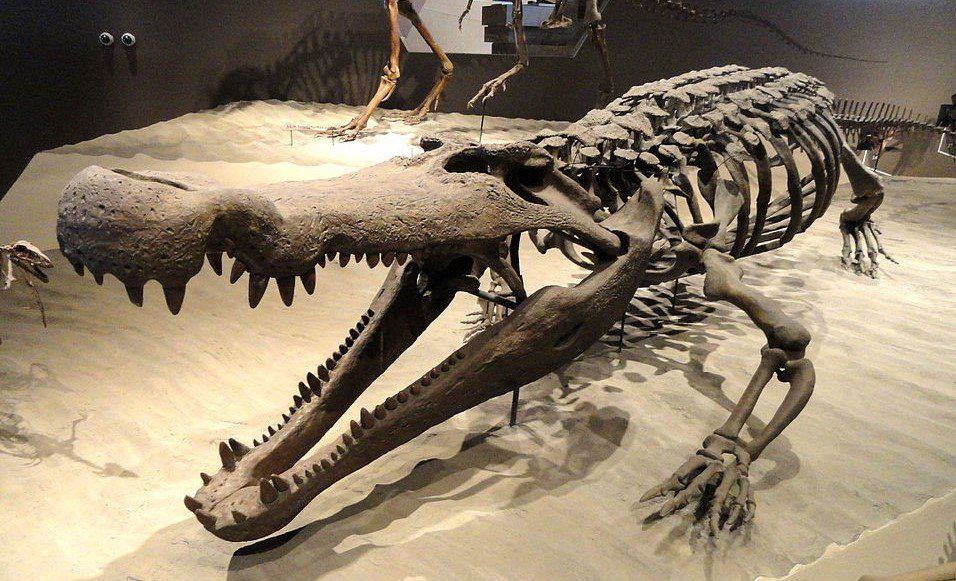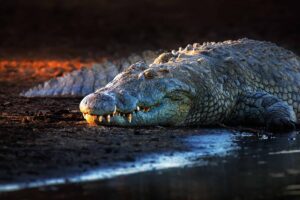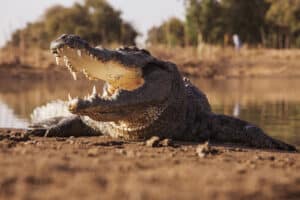Pitting the biggest modern alligators against the largest modern crocodiles is a joke. The strongest crocodile simply overwhelms the smaller, weaker, and less adaptable alligators. That’s why we want to take things back millions of years and pick out the true heavyweights of each species. We’re going to host a hypothetical fight between the largest ever alligator vs. the largest crocodile the planet has ever seen.
Specifically, the largest alligator relative was a massive reptile called Deinosuchus hatcheri. Meanwhile, the crocodiles are represented by Sarcosuchus imperator, a gigantic crocodile that may have even attacked some dinosaurs. Who wins this battle and why? Let’s start this battle by breaking down some statistics.
Comparing the Largest Ever Alligator and the Largest Crocodile
| The Largest Ever Alligator | The Largest Crocodile | |
|---|---|---|
| Size | Weight: from 5,500 pounds to 11,000 pounds Length: from 26 to 39 feet | Weight: from 6,800 pounds to 9,400 pounds based on the latest estimates Length: roughly 31 feet |
| Speed | – Unknown top speed, but its size may have made it hard to move quickly on land – Large modern alligators move at about 12 mph on land – Modern alligators swim at between 10 and 15 mph, up to 20 mph at their fastest | – No estimates on speed – Modern saltwater crocodiles can move at 12 mph over very short distances on land – Swimming speed of 15 to 18 mph based on saltwater crocodiles |
| Defenses | – Had a very large body that was reinforced with osteoderms – Thick skin would make it difficult to harm this creature – Probably hid in water and areas surrounding it by blending in | – The crocodile’s size would frighten off most challengers – The ability to hide and fight in water would reduce any potential danger to it – Massive body was reinforced with osteoderms and strong skin |
| Offensive Capabilities | – Had teeth measuring between 2 and 8 inches long – They would bite, grab, and pull prey into the water – Had a bite force of 23,100 PSI – Studies confirm this creature could have used a death roll | – Had a bite power of about 18,000 PSI – Possessed 100 sharp teeth that measured up to 6 inches long – May have bitten prey and torn it apart, but it could not do the death roll. |
| Predatory Behavior | – Most likely was an apex predator that was not hunted in adulthood – Was most likely an ambush predator like modern alligators | – Probably ambushed their prey while submerged or partially submerged |

are part of the crocodylians — the group that includes modern alligators, crocodiles and gharials.
©Daderot / CC0 1.0 – License
What Are 3 Key Differences Between the Largest Ever Alligator vs. the Largest Crocodile?
The most significant differences between the largest ever alligator and the largest crocodile are their size, bite force, and attack methods. The largest ever alligator weighed from 5,500 pounds to 11,000 pounds while the largest crocodile weighed between 6,800 and 9,400 pounds.
Meanwhile, the largest ever alligator had a bite force of about 23,000 PSI while the largest crocodile had a bite force of about 18,000 PSI. Lastly, the largest ever alligator would attack using a combination of bites and a death roll, but the largest crocodile probably could not execute that move. Instead, it would have relied on biting and overpowering its prey.
These elements will play a significant role in this fight, but we still need more data to name a winner.
What Are the Key Factors in a Fight Between the Largest Ever Alligator and the Largest Crocodile?
The battle between the largest ever alligator and the largest crocodile will be decided by five factors. These factors include elements of size, speed, offensive power, predatory abilities, and defenses. While we have valuable data for some of these factors, some of them are lacking due to the reptiles being so old.
With that in mind, we’re going to compare each reptile based on five key factors, see which of them had the advantage in each, and take that data and use it to figure out the overall winner. Let’s get to it!
The Largest Ever Alligator vs the Largest Crocodile: Size
The largest ever alligator was bigger than the largest crocodile. Deinosuchus weighed anywhere from 5,500 pounds to 11,000 pounds while it roamed the planet, and it could grow to lengths of 39 feet.
Meanwhile, Sarcosuchus only weighed about 6,800 pounds to 9,400 pounds based on the most recent discoveries that effectively diminished the creature’s potential size based on estimates from its skull. The largest crocodile measured about 31 feet long.
The largest ever alligator has the advantage in this fight.
The Largest Ever Alligator vs the Largest Crocodile: Speed
We don’t know about either creature’s true speed. We only know that they were probably less effective on land than they were in the water. Their immense size would make it hard to scamper on land at a high speed for very long. In that way, both species are similar to their modern counterparts.
That being said, we know that modern alligators swim at speeds between 10 and 20 mph at their fastest, but very large saltwater crocodiles only swim between 15 and 18 mph.
Based on the lack of information, we’re not assigning a speed advantage in this fight.

Crocodylomorph fossils have been discovered on every continent except Antarctica, and there is abundant fossil evidence for this ancient and populous group of creatures.
©iStock.com/Homo Cosmicos
The Largest Alligator vs the Largest Crocodile: Defenses
Both the Sarchosuchus and the Deinosuchus were similar in terms of defenses. They relied on their large size and ability to stay hidden in the water to keep them safe. Moreover, they both had bodies reinforced with osteoderms, or scutes, along with very tough skin. Their body composition would make it hard to deal damage to them unless an extraordinary force was applied.
More importantly, the creatures’ large bodies ensured that it would take some of the largest creatures around to inflict fatal damage to these creatures.
The largest alligator and the largest crocodile are tied in physical defenses, but it’s important to remember that Deinosuchus was larger.
The Largest Ever Alligator vs the Largest Crocodile: Offensive Capabilities
The largest crocodile ever and the largest ever alligator both relied on their bites to kill their prey. The largest ever alligator had between 30 and 60 teeth that measured between 2 and 8 inches long at their greatest. This animal could bite with a force of about 23,100 PSI.
Also, the largest ever alligator had stronger jaws and a snout that suggests it could have performed a death roll. That is when the creature bites an animal and then rolls over and over to disorient, drown, or amputate limbs depending on where the bite occurs.
New evidence about the snout size and jaw strength of Sarcosuchus suggests that they could not perform a death roll. Nevertheless, they could bite with an immense force of about 18,000 PSI. They also had 100 sharp teeth that could have measured up to 6 inches long. Even though the crocodile didn’t have the death roll in its arsenal, the creature could simply chomp down and exsanguinate its prey.
Deinosuchus has the offensive advantage in this fight.
The Largest Ever Alligator and the Largest Crocodile: Predatory Behavior
The largest crocodile and the largest ever alligator were probably similar in their predatory behavior. They would likely wait near the water’s edge while partially or totally submerged.
When a creature stopped by the body of water for a drink, these creatures would lunge forth, grab them, and bring them into the water. Unable to escape their grasp, the creatures’ prey would drown, bleed to death, have major organs punctured, or become subject to a brutal death roll.
Both creatures are tied in terms of predatory behavior.
Who Would Win in a Fight Between the Largest Ever Alligator and the Largest Crocodile?
The largest ever alligator would win a fight against the largest crocodile. Even though these two reptiles had many similarities, Deinosuchus had enough advantages that it would win in a head-to-head fight.
The largest ever alligator had a stronger bite, stronger jaws, longer teeth, the ability to perform a death roll, and a potentially huge weight advantage. Based on their largest estimates, Deinosuchus may have outweighed the crocodile by almost 2,000 pounds and measured 8 feet longer!
Outside of specialty attacks like venom, most fights in the wild favor the larger, stronger creature. In this case, that is the Deinosuchus. The fight would be brutal, bloody, and long-lasting. The two creatures would be in a contest to cause more damage to their foe than they took.
Realistically, though, much of the fight would be determined by which creature would land the first devastating blow. We can’t know if the alligator or the crocodile would land a bite first. So, we’re calling this fight in favor of the alligator for all the reasons listed above.
How Can You Tell an Alligator and a Crocodile Apart?

We’ve looked at some differences between the largest alligator vs crocodile ever, and have seen that the largest alligator ever outclassed the largest crocodile in multiple areas. But if you were in an area where modern-day alligators and crocodiles co-existed, would you be able to tell them apart?
In terms of physical characteristics, an alligator has a U-shaped snout, webbed feet, a wide upper jaw that hides the lower teeth and overlaps the lower jaw, and roughly 80 teeth. Its teeth measure from 1 inch for its smaller teeth to as much as 2 ½ inches for its largest. In color, alligators are dark gray or black with a cream underbelly.
Crocodiles, by comparison, have V-shaped snouts, feet that are not webbed but possess a jagged fringe, and upper and lower jaws that are roughly the same size, allowing the teeth to
Interdigitate. Crocodiles possess 60-70 teeth that are slightly curved and conical and protrude when their mouths are closed. Saltwater crocs have 66 teeth, some of which grow as long as 5 inches. Crocodiles’ teeth are not sharp, but are blunt, as they use them to hold prey tight rather than ripping them apart. Crocodiles are mostly olive green or light brown with a mottled pattern.
Alligators can be found in 2 locations–America (the American alligator) and China (the Chinese alligator). Crocodiles can be found in many more places worldwide: Egypt and 25 other countries in Africa (Nile crocodile), Asia, Oceania, South Florida, and South America (American crocodile). Regarding habitat, alligators prefer freshwater areas like swamps, rivers, lakes, ponds, and wetlands, while crocodiles are able to tolerate salt water, enabling them to inhabit lagoons and islands, as well as rivers, lakes, and mangrove swamps.
As far as prey goes, you’d likely observe either the alligator or crocodile eating the same animals: fish, birds, turtles, and various mammals. They are both apex predators that primarily consume other animals as their sole source of nutrition.
Finally, they differ in size. While alligators weigh from 400 lbs to 800 lbs and range in length from 8.2 feet to 11.2 feet, crocodiles are larger animals, measuring 10 feet to 20 feet long and weighing 300 lbs to 2,000 lbs. So if you are observing one of these reptiles in the wild, you’ll need to take into account its unique characteristics, its size, and the area you are observing it in to determine whether it’s an alligator or a crocodile.
The photo featured at the top of this post is © iStock.com/Homo Cosmicos
Thank you for reading! Have some feedback for us? Contact the AZ Animals editorial team.






